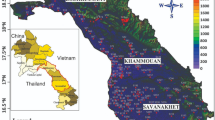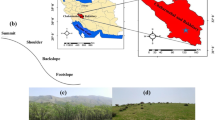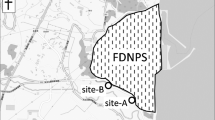Abstract
Purpose
The area of southeastern Serbia, the Pčinja and South Morava River Basins, is under the influence of very strong erosion, and the aim of this study was to investigate the vertical and spatial distribution of the 137Cs in the eroded soils of this area.
Materials and methods
Vertical soil profiles were collected with 5-cm increments from the uppermost layer down to 20, 25, 30, 40, and 50 cm of depth, depending on the thickness of the soil layers, i.e., down to the underlying parent rocks. Measurements of 137Cs activity concentration were performed by using the HPGe gamma-ray spectrometer ORTEC-AMETEK (34 % relative efficiency and high resolution 1.65 keV at 1.33 MeV for 60Co), from its gamma-ray line at 661.2 keV.
Results and discussion
The mean 137Cs activity concentration across all 18 soil profiles (for all soil layers) was found to be 20 Bq kg−1. In the greatest number of soil profiles, the 137Cs activity concentration was generally highest in the first soil layer (0–5 cm) and decreased with soil depth, while in a few soil profiles, the peak of either the 137Cs activity concentration occurred in the second soil layer (5–10 cm) or the 137Cs activity concentration was almost equal throughout the entire soil profile. The mean 137Cs activity concentration in the first soil layer (0–5 cm) was found to be 61 Bq kg−1, and the high coefficient of variation of 92 % pointed out high spatial variability and large range of the 137Cs activity concentrations in the study area.
Conclusions
The obtained results indicate that in the greatest number of soil profiles, 137Cs is present in the upper layers, with concentration decreasing with depth, as is typical in uncultivated soil. Its spatial distribution was very uneven among the surface soil layers of the investigated sites. One of the main reasons for such pattern of 137Cs in the study area may be soil erosion. Additional investigations which would support this hypothesis are required.


Similar content being viewed by others
References
Al-Masri MS (2006) Vertical distribution and inventories of 137Cs in the Syrian soils of the eastern Mediterranean region. J Environ Radioact 86:187–198
Babović M, Cvetković D (1977) Trgovište with Radomir. In: Dimitrijević M, Dragić D, Karamata S, Sikošek B, Veselinović D (eds) Basic geological map 1:100000. Socialist Federal Republic of Yugoslavia. Federal Geological Institute, Belgrade, pp 34–57
Barišić D, Vertacnik A, Lulić S (1999) Caesium contamination and vertical distribution in undisturbed soils in Croatia. J Environ Radioact 46:361–374
Bikit I, Slivka J, Lj Č, Krmar M, Vesković M, Žikić-Todorović N, Varga E, Čurčić S, Mrdja D (2005) Radioactivity of the soil in Vojvodina (northern province of Serbia and Montenegro). J Environ Radioact 78:11–19
Bonnett PJP (1990) A review of the erosional behaviour of radionuclides in selected drainage basins. J Environ Radioact 11:251–266
Bossew P, Kirchner G (2004) Modelling the vertical distribution of radionuclides in soil. Part 1: the convection–dispersion equation revisited. J Environ Radioact 73:127–150
Bossew P, Gastberger M, Gohla H, Hofer P, Hubmer A (2004) Vertical distribution of radionuclides in soil of a grassland site in Chernobyl exclusion zone. J Environ Radioact 73:87–99
Dragović S, Gajić B, Dragović R, Janković-Mandić L, Slavković-Beškoski L, Mihailović N, Momčilovć M, Ćujić M (2012a) Edaphic factors affecting the vertical distribution of radionuclides in the different soil types of Belgrade, Serbia. J Environ Monit 14:127–137
Dragović S, Janković-Mandić L, Dragović R, Đorđević M (2012b) Natural and man-made radionuclides in soil as sources of radiation exposure. In: Balenovic D, Stimac E (eds) Radiation exposure: sources, impacts and reduction strategies. Nova Science Publishers, Inc., New York, pp 1–42
Dugalić G, Gajić B (2012) Pedology. University of Kragujevac (in Serbian)
Dugalic G, Krstic D, Jelic M, Nikezic D, Milenkovic B, Pucarevic M, Zeremski-Skoric T (2010) Heavy metals, organics and radioactivity in soil of western Serbia. J Hazard Mater 177:697–702
Dumat C, Cheshire MV, Fraser AR, Shand CA, Staunton SS (1997) The effect of removal of soil organic matter and iron on the adsorption of radiocaesium. Eur J Soil Sci 48:675–683
FAO (Food and Agriculture Organization) (2006) World reference base for soil resources, a framework for international classification, correlation and communication. FAO, Rome
Grdović S, Vitorović S, Mitrović B, Andrić V, Petrujkić B, Obradović M (2010) Natural and anthropogenic radioactivity of feedstuffs, mosses and soil in the Belgrade environment, Serbia. Arch Biol Sci 62:301–307
Haciyakupoglu S, Ahmet Ertek T, Walling DE, Fatih Ozturk Z, Karahan G, Evren Erginal A, Celebi N (2005) Using caesium-137 measurements to investigate soil erosion rates in western Istanbul (NW Turkey). Catena 64:222–231
IAEA (International Atomic Energy Agency) (1989) Measurement of radionuclides in food and the environment, a guidebook, technical report series no.295. IAEA, Vienna
IAEA (International Atomic Energy Agency) (2004) Soil sampling for environmental contaminants. IAEATECDOC-1415. IAEA, Vienna
Isaksson M, Erlandsson B (1995) Experimental-determination of the vertical and horizontal distribution of Cs-137 in the ground. J Environ Radioact 27:141–160
Ivanov YA, Lewyckyj N, Levchuk SE, Prister BS, Firsakova SK, Arkhipov NP, Arkhipov AN, Kruglov SV, Alexakhin RM, Sandalls J, Askbrant S (1997) Migration of Cs-137 and Sr-90 from Chernobyl fallout in Ukrainian, Belarussian and Russian soils. J Environ Radioact 35:1–21
Janković-Mandić L, Dragović R, Đorđević M, Đolić M, Onjia A, Dragović S, Bačić G (2014) Spatial variability of 137Cs in the soil of Belgrade region (Serbia). Hem Ind 68:449–455
Kirchner G (1998) Applicability of compartmental models for simulating the transport of radionuclides in soil. J Environ Radioact 38:339–352
Krstic D, Nikezic D, Stevanovic N, Jelic M (2004) Vertical profile of Cs-137 in soil. Appl Radiat Isot 61:1487–1492
Lazarević R (1983) Erosion map of the Republic of Serbia 1:500000. Institute of Forestry and Wood Industry of Serbia. Department for erosion and Reclamation, Belgrade
Likar A, Omahen G, Lipoglavsek M, Vidmar T (2001) A theoretical description of diffusion and migration of Cs-137 in soil. J Environ Radioact 57:191–201
Nimis PL (1996) Radiocesium in plants of forest ecosystems. Studia Geobot 15:3–49
ORTEC (2001) Gamma vision 32, gamma-ray spectrum analysis and MCA emulation. Version 5.3. ORTEC, Oak Ridge
Petrović J, Ćujić M, Đorđević M, Gajić B, Miljanić Š, Dragović S (2013) Spatial distribution and vertical migration of 137Cs in soils of Belgrade (Serbia) 25 years after the Chernobyl accident. Environ Sci: Processes Impacts 15:1279–1289
Porto P, Walling DE, Ferro V (2001) Validating the use of cesium-137 measurements to estimate soil erosion rates in small drainage basin in Calabria, Southern Italy. J Hydrol 248:93–108
Porto P, Wallig DE, Ferro V, Di Stefano C (2003) Validating erosion rate estimates provided by caesium-137 measurements for two small forested catchments in Calabria, Southern Italy. Land Degrad Dev 14:389–408
Republic Hydrometeorological Service of Serbia (2011). Annual Meteorological Report, Republic Hydrometeorological Service of Serbia, Belgrade
Ritchie JC, McHenry JR (1990) Application of radiation fallout caesium-137 for measuring soil erosion and sediment accumulation rates and patterns: a review. J Environ Qual 19:215–233
Rogowski AS, Tamura T (1970) Environmental mobility of cesium-137. Radiat Bot 10:35–45
Rowell DL (1997) Bodenkunde. Untersuchungsmethoden und ihre Anwendungen. Springer, Berlin
Schuller P, Ellies A, Kirchner G (1997) Vertical migration of fallout Cs-137 in agricultural soils from southern Chile. Sci Total Environ 193:197–205
Şensoy H, Kara Ö (2014) Slope shape effect on runoff and soil erosion under natural rainfall conditions. iForest - Biogeosciences and Forestry 7:110–114
Smith JT, Elder DG (1999) A comparison of models for characterizing the distribution of radionuclides with depth in soils. Euro J Soil Sci 50:295–307
SPSS (Statistical Package for the Social Sciences) (2007) Version 16.0. Chicago, Illinois
USDA (United States Department of Agriculture) (1999) Soil taxonomy. A basic system of soil classification for making and interpreting soil surveys. Handbook No. 436. Soil Survey Staff, Washington DC
Walling DE, He Q (1999) Improved models for estimating soil erosion rates from cesium-137 measurements. J Environ Qual 28:611–622
Walling DE, Zhang Y, He Q (2006) Models for converting measurements of environmental radionuclide inventories (137Cs, excess 210Pb, and 7Be) to estimates of soil erosion and deposition rates (including software for model implementation). Department of Geography, University of Exeter, Exeter, U. K. Report
Zlatković B (2011) Floristic analysis of the valley of Pčinja River S Serbia, PhD Thesis, University of Belgrade (in Serbian)
Acknowledgments
This work was supported by the Ministry of Education, Science and Technological Development of the Republic of Serbia (Project no. III43009).
Author information
Authors and Affiliations
Corresponding author
Additional information
Responsible editor: Jaume Bech
Rights and permissions
About this article
Cite this article
Petrović, J., Dragović, S., Dragović, R. et al. Spatial and vertical distribution of 137Cs in soils in the erosive area of southeastern Serbia (Pčinja and South Morava River Basins). J Soils Sediments 16, 1168–1175 (2016). https://doi.org/10.1007/s11368-015-1192-5
Received:
Accepted:
Published:
Issue Date:
DOI: https://doi.org/10.1007/s11368-015-1192-5




